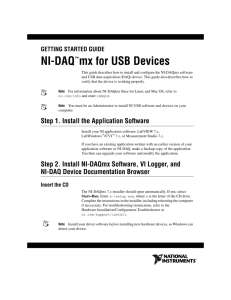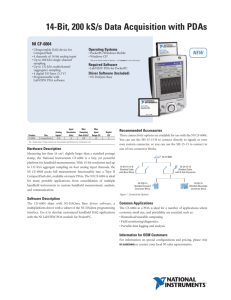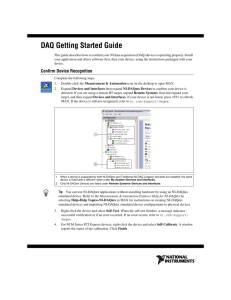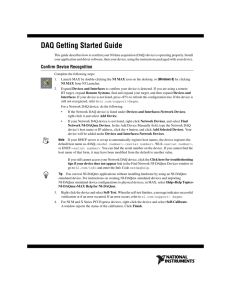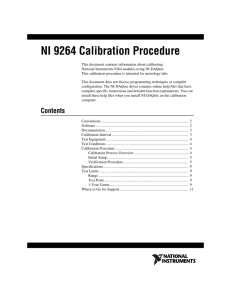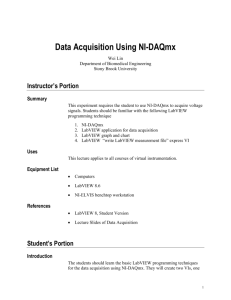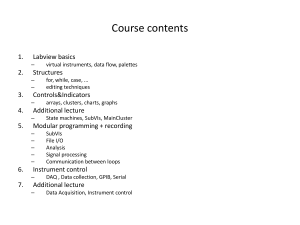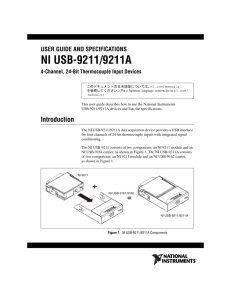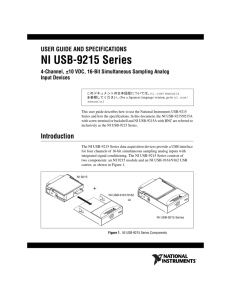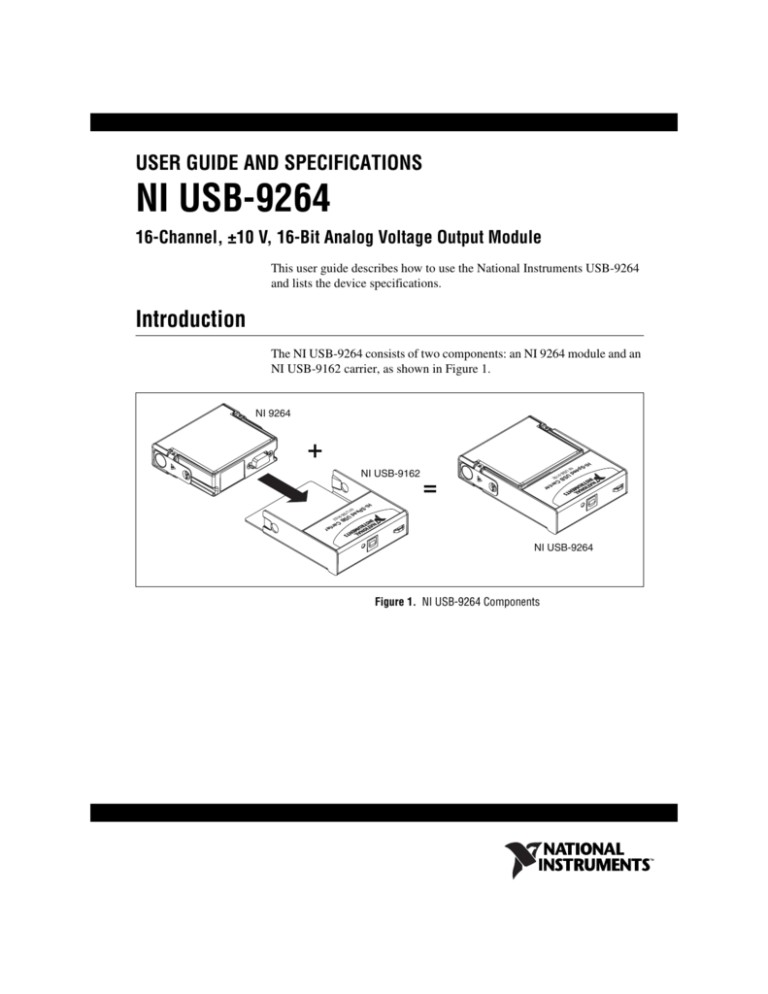
USER GUIDE AND SPECIFICATIONS
NI USB-9264
16-Channel, ±10 V, 16-Bit Analog Voltage Output Module
This user guide describes how to use the National Instruments USB-9264
and lists the device specifications.
Introduction
The NI USB-9264 consists of two components: an NI 9264 module and an
NI USB-9162 carrier, as shown in Figure 1.
NI 9264
Hi-
Sp
N
IU
S
B
-9
16
2
eed
US
BC
arr
NI USB-9162
ier
Hi-
eed
SP
N
IU
S
B
-9
16
2
NI USB-9264
Figure 1. NI USB-9264 Components
US
BC
arr
ier
Dimensions
Figure 2 shows the NI USB-9264 device dimensions.
Hi-Speed USB Carrier
NI USB-9162
120.68 mm
(4.751 in.)
118.26 mm
(4.656 in.)
88.12 mm
(3.469 in.)
25.34 mm
(0.998 in.)
Figure 2. NI USB-9264 Device Dimensions in Millimeters (Inches)
Safety Guidelines
Operate the NI USB-9264 only as described in this user guide.
Hot Surface This icon denotes that the component may be hot. Touching this component
may result in bodily injury.
Safety Guidelines for Hazardous Voltages
A hazardous voltage is a voltage greater than 42.4 Vpk or 60 VDC to earth
ground. If hazardous voltages are connected to the module, take the
following precautions.
Ensure that hazardous voltage wiring is performed only by qualified personnel
adhering to local electrical standards.
Caution
Caution
Do not mix hazardous voltage circuits and human-accessible circuits on the same
module.
Make sure that devices and circuits connected to the module are properly
insulated from human contact.
Caution
NI USB-9264 User Guide and Specifications
2
ni.com
When module terminals are hazardous voltage LIVE (>42.4 Vpk/60 VDC), you
must ensure that devices and circuits connected to the module are properly insulated from
human contact. You must use the NI 9940 connector backshell kit, illustrated in Figure 3,
to ensure that the terminals are not accessible.
Caution
Figure 3. NI 9940 Connector Backshell
Related Documentation
Each application software package and driver includes information about
writing applications for taking measurements and controlling measurement
devices. Check ni.com/manuals for the most recent hardware
documentation, and refer to Table for a list of locations for driver and
application software documentation. The following document location
references assume you have NI-DAQmx 8.9 or later, and where applicable,
version 7.1 or later of the NI application software.
© National Instruments Corporation
3
NI USB-9264 User Guide and Specifications
Table 1. Related Documentation
Software
NI-DAQmx for Windows
LabVIEW
NI USB-9264 User Guide and Specifications
Document/Description
Location/Topic
DAQ Getting Started Guide—
describes how to install the
NI-DAQmx for Windows
software, your NI-DAQmx
supported DAQ device, and
how to confirm that your
device is operating properly.
Start»All Programs»
National Instruments»
NI-DAQ»DAQ Getting
Started Guide
NI-DAQ Readme—lists which
devices are supported by this
version of NI-DAQmx.
Start»All Programs»
National Instruments»
NI-DAQ»NI-DAQ Readme
NI-DAQmx Help—contains
general information about
measurement concepts, key
NI-DAQmx concepts, and
common applications that
are applicable to all
programming environments.
Start»All Programs»
National Instruments»
NI-DAQ»NI-DAQmx Help
Getting Started with
LabVIEW—describes the
LabVIEW graphical
programming environment and
the basic LabVIEW features
you use to build data
acquisition and instrument
control application.
Start»All Programs»
National Instruments»
LabVIEW»LabVIEW
Manuals or navigate to the
labview\manuals directory
and open
LabVIEW Help—provides
information about LabVIEW
programming concepts,
step-by-step instructions for
using LabVIEW, and reference
information about LabVIEW
VIs, functions, palettes,
menus, and tools.
Help»Search the LabVIEW
Help
4
LV_Getting_Started.pdf
ni.com
Table 1. Related Documentation (Continued)
Software
Document/Description
Location/Topic
LabVIEW Help Topics Specific to NI-DAQmx
Location
Description
From the Contents tab,
Getting Started»Getting
Started with DAQ
Includes overview information and a tutorial to learn how to take
an NI-DAQmx measurement in LabVIEW using the DAQ
Assistant.
From the Contents tab,
VI and Function Reference»
Measurement I/O VIs and
Functions
Describes the LabVIEW NI-DAQmx VIs and properties.
From the Contents tab,
Taking Measurements
Contains the conceptual and how-to information you need to
acquire and analyze measurement data in LabVIEW, including
common measurements, measurement fundamentals,
NI-DAQmx key concepts, and device considerations.
LabWindows™/CVI™
LabWindows/CVI Help Data
Acquisition book—contains
NI-DAQmx measurement
concepts and step-by-step
instructions about creating a
measurement task using the
DAQ Assistant.
Help»Contents, then select
Using LabWindows/CVI»
Data Acquisition»Taking an
NI-DAQmx Measurement in
LabWindows/CVI
LabWindows/CVI Help
NI-DAQmx Library
book—contains NI-DAQmx
API overviews and function
reference.
LibraryReference»
NI-DAQmx Library
Measurement Studio/
Microsoft Visual Studio .NET
Microsoft Visual Studio .NET
Help/NI Measurement Studio
Help—contains NI-DAQmx
methods and properties.
Measurement Studio»
NI Measurement Studio
Help and select NI-DAQmx
.NET Class Library or
NI-DAQmx Visual C++
Class Library
ANSI C without
NI Application Software
NI-DAQmx Help
Start»All Programs»
National Instruments»
NI-DAQ»NI-DAQmx Help
NI-DAQmx C Reference
Help—describes the
NI-DAQmx Library functions.
Start»All Programs»
National Instruments»
NI-DAQ»NI-DAQmx
C Reference Help
© National Instruments Corporation
5
NI USB-9264 User Guide and Specifications
Table 1. Related Documentation (Continued)
Software
Document/Description
.NET Languages without
NI Application Software*
Location/Topic
NI-DAQmx .NET
Help—contains conceptual
topics for using NI-DAQmx
with Visual C# and Visual
Basic .NET.
Start»All Programs»
National Instruments»
NI-DAQ»NI-DAQmx .NET
Reference Help. Expand
NI Measurement Studio
Help»NI Measurement
Studio .NET Class Library»
Reference to view the function
reference. Expand
NI Measurement Studio
Help»NI Measurement
Studio .NET Class Library»
Using the Measurement
Studio .NET Class Libraries
Visual Studio .NET
Help—contains conceptual
topics for using NI-DAQmx
with Visual C# and Visual
Basic .NET.
Help»Contents. Select
Measurement Studio from
the Filtered By drop-down list
and follow the location
instructions for the NI-DAQmx
.NET Help.
* With
the Microsoft .NET Framework version 1.1 or later, you can use NI-DAQmx to create applications using Visual C#
and Visual Basic .NET without Measurement Studio. You need Microsoft Visual Studio .NET 2003 or Microsoft Visual
Studio 2005 for the API documentation to be installed.
Device Documentation and Specifications
Check ni.com/manuals for the most recent device and software
documentation. If you do not have Web access, NI-DAQmx includes a
Documentation CD that includes documentation available when
NI-DAQmx released.
Training Courses
If you need more help getting started developing an application with
NI products, NI offers training courses. To enroll in a course or obtain
a detailed course outline, refer to ni.com/training.
Technical Support on the Web
For additional support, refer to ni.com/support or zone.ni.com.
NI USB-9264 User Guide and Specifications
6
ni.com
Installing the Software
Software support for the NI USB-9264 for Windows Vista/XP is provided
by NI-DAQmx. The DAQ Getting Started Guide, which you can download
at ni.com/manuals, offers NI-DAQmx users step-by-step instructions
for installing software and hardware, configuring channels and tasks, and
getting started developing an application.
Installing Other Software
If you are using other software, refer to the installation instructions that
accompany your software.
Example Programs
The NI-DAQmx media contains example programs that you can use to get
started programming with the NI USB-9264. Refer to the NI-DAQmx for
USB Devices Getting Started Guide that shipped with your device, and
is also accessible from Start»All Programs»National Instruments»
NI-DAQ, for more information.
Mounting the NI USB-9264 to a Panel
Threaded inserts are located in the NI USB-9162 for mounting it to a panel.
Mount the NI USB-9162 before inserting the NI 9264. Refer to Figure 4 for
dimensions.
85.7 mm
(3.37 in.)
72.2 mm
(2.84 in.)
Threaded Insert
M3 x 0.5
8.5 mm (0.34 in.) Max Depth
76.1 mm
(3.00 in.)
Figure 4. Module Mounting Dimensions In Millimeters (Inches)
© National Instruments Corporation
7
NI USB-9264 User Guide and Specifications
Installing the NI USB-9264 Device
Before installing the device, you must install the software you plan to use
with the device. Refer to the Installing the Software section of this guide
and the documentation included with the software for more information.
Installing the NI 9264 Module into the NI USB-9162 Carrier
The NI 9264 module and NI USB-9162 carrier are packaged separately.
Refer to Figure 5, while completing the following assembly steps:
1.
Make sure that no signals are connected to the NI 9264 module and the
USB cable is not attached to the USB-9162 carrier.
2.
Remove the protective cover from the 15-pin D-SUB connector.
3.
Align the I/O module with the carrier, as shown in Figure 5.
Figure 5. Module Installation
4.
Squeeze the latches and insert the NI 9264 module into the
NI USB-9162 carrier.
5.
Press firmly on the connector side of the NI 9264 module until the
latches lock the module into place, as shown in Figure 6.
Figure 6. Locking Module into Place
NI USB-9264 User Guide and Specifications
8
ni.com
Connecting the NI USB-9264 to a Computer
Plug one end of the USB cable into the NI USB-9264 and the other end into
an available USB port on the computer. Refer to the NI-DAQmx for USB
Devices Getting Started Guide that shipped with your device, and is also
accessible from Start»All Programs»National Instruments»NI-DAQ,
for more information.
LED Indicator
The NI USB-9264 device has a green LED next to the USB connector. The
LED indicator indicates device status, as listed in Table 2. When the device
is connected to a USB port, the LED blinks steadily to indicate that the
device is initialized and is receiving power from the connection.
If the LED is not blinking, it may mean that the device is not initialized or
the computer is in standby mode. In order for the device to be recognized,
the device must be connected to a computer that has NI-DAQmx installed
on it. If your device is not blinking, make sure your computer has the latest
version of NI-DAQmx installed on it, and the computer is not in standby
mode.
Table 2. LED State/Device Status
LED State
© National Instruments Corporation
Device Status
Not lit
Device not connected or in suspend.
On, not blinking
Device connected, but no module installed.
Single-blink
Operating normally.
Double-blink
Operating normally.
Quadruple-blink
Device error. Refer to ni.com/support.
9
NI USB-9264 User Guide and Specifications
Wiring the NI USB-9264 Device
The NI USB-9264 has a 36-terminal detachable spring-terminal connector
that provides connections for 16 analog output channels.
A high voltage screw terminal backshell must be installed when using hazardous
voltages (>42.4 Vpk, 60 VDC).
Caution
AO0
AO1
AO2
AO3
AO4
AO5
AO6
AO7
AO8
AO9
AO10
AO11
AO12
AO13
AO14
AO15
COM
COM
1
2
3
4
5
6
7
8
9
10
11
12
13
14
15
16
17
18
19
20
21
22
23
24
25
26
27
28
29
30
31
32
33
34
35
36
COM
COM
COM
COM
COM
COM
COM
COM
COM
COM
COM
COM
COM
COM
COM
COM
COM
COM
Figure 7. NI USB-9264 Terminal Assignments
Each channel of the NI USB-9264 has a terminal to which you can connect
the positive lead of a load. Each channel also has a common terminal,
COM, and there are four additional COM terminals at the bottom of the
connector. All of the COM terminals are internally connected to the
isolated ground reference of the module. When connecting a load to the
NI USB-9264, connect the positive lead of the load to the AO terminal, and
the ground of the load to a COM terminal. Refer to Figure 8 for an
illustration of connecting a load to the NI USB-9264.
AO
Load
NI USB-9264
COM
Figure 8. Connecting a Load to the NI USB-9264
NI USB-9264 User Guide and Specifications
10
ni.com
Each channel has a digital-to-analog converter (DAC) that produces a
voltage signal. Each channel also has overvoltage and short-circuit
protection. Refer to the Specifications section for more information about
overvoltage and short-circuit protection. Refer to Figure 9 for an
illustration of the output circuitry for one channel of the NI USB-9264.
Isolated
DAC
Overvoltage/
Short-Circuit
Protection
Amp
AO
COM
NI USB-9264
Figure 9. Output Circuitry for One Channel of the NI USB-9264
When the module powers on, the channels output the startup voltage. Refer
to the Specifications section for more information about startup voltage.
Refer to the software help for information about configuring startup output
states in software.
Connecting Wires to the NI USB-9264 Connector
Use a flathead screwdriver with a blade smaller than 2.3 × 1.0 mm
(0.09 × 0.04 in.) to connect wires to the detachable spring-terminal
connector. Insert the screwdriver into a spring clamp activation slot and
press a wire into the corresponding connector terminal, then remove the
screwdriver to clamp the wire into the terminal. Refer to the Specifications
section for more information about spring-terminal wiring. Refer to
Figure 10 for an illustration of connecting wires to the NI USB-9264.
Figure 10. Connecting Wires to the NI USB-9264 Terminals
© National Instruments Corporation
11
NI USB-9264 User Guide and Specifications
Wiring for High-Vibration Applications
If an application is subject to high vibration, National Instruments
recommends that you use the NI 9940 backshell kit to protect the
connections. Refer to Figure 3 for an illustration of the NI 9940 connector
backshell.
Specifications
The following specifications are typical for the range –40 to 70 °C
unless otherwise noted. All voltages are relative to COM unless otherwise
noted.
Output Characteristics
Number of channels................................16 analog output channels
DAC resolution.......................................16 bits
Type of DAC ..........................................String
Output range
Minimum .........................................±10.35 V
Typical.............................................±10.5 V
Maximum ........................................±10.65 V
Current drive...........................................±16 mA all channels max;
±4 mA per channel typ
Power-on output state .............................Channels off
Startup voltage ........................................0 V1
Power-down voltage ...............................0 V2
Output impedance...................................2.0 Ω
1
2
When the module powers on, a glitch occurs for 20 ms peaking at 500 mV.
The power-down voltage peaks at 1.7 V, then exponentially discharges to 0 V in 200 ms. You can add a load to reduce peak
voltage.
NI USB-9264 User Guide and Specifications
12
ni.com
Accuracy
Percent of
Reading
(Gain Error)
Percent of
Range*
(Offset
Error)
Calibrated, max (–40 to 70 °C)
0.15%
0.15%
Calibrated, typ (25 °C)
0.05%
0.05%
Uncalibrated, max (–40 to 70 °C)
0.6%
1.0%
Uncalibrated, typ (25 °C)
0.2%
0.25%
Measurement Conditions
* Range equals 10.5 V
Stability
Gain drift......................................... 6 ppm/°C
Offset drift....................................... 80 μV/°C
Protection
Overvoltage..................................... ±27 V at 25 °C
Short-circuit .................................... Indefinitely
Noise ...................................................... 500 μVrms
Crosstalk................................................. 90 dB
Settling time (100 pF load, to 1 LSB)
20 V step ......................................... 20 μs
1 V step ........................................... 15 μs
0.1 V step ........................................ 13 μs
Capacitive drive ..................................... 1,500 pF max
Monotonicity.......................................... 16 bits
DNL ....................................................... +1 LSB max
INL (endpoint) ....................................... ±12 LSBs max
Power Requirements
Current consumption from USB ............ 1 W max
Suspend mode ........................................ 2.5 mA, max
© National Instruments Corporation
13
NI USB-9264 User Guide and Specifications
Bus Interface
USB specification ...................................USB 2.0 Hi-Speed
Physical Characteristics
Spring-terminal wiring ...........................18 to 28 AWG copper conductor
wire with 7 mm (0.28 in.) of
insulation stripped from the end
Weight ....................................................239 g (8.4 oz)
Safety
If you need to clean the module, wipe it with a dry towel.
Isolation Voltages
Channel-to-channel.................................None
Channel-to-earth ground
Continuous.......................................250 Vrms,
Measurement Category II
Withstand.........................................2,300 Vrms, verified by a 5 s
dielectric withstand test
Measurement Category II is for measurements performed on circuits
directly connected to the electrical distribution system. This category refers
to local-level electrical distribution, such as that provided by a standard
wall outlet, for example, 115 V for U.S. or 230 V for Europe.
Caution Do not connect the NI USB-9264 to signals or use for measurements within
Measurement Categories III or IV.
Safety Standards
This product is designed to meet the requirements of the following
standards of safety for electrical equipment for measurement, control, and
laboratory use:
•
IEC 61010-1, EN 61010-1
•
UL 61010-1, CSA 61010-1
Note For UL and other safety certifications, refer to the product label or visit ni.com/
certification, search by module number or product line, and click the appropriate link
in the Certification column.
NI USB-9264 User Guide and Specifications
14
ni.com
Environmental
National Instruments C Series modules are intended for indoor use only but
may be used outdoors if installed in a suitable enclosure.
Operating temperature
(IEC 60068-2-1, IEC 60068-2-2)........... –40 to 70 °C
Storage temperature
(IEC 60068-2-1, IEC 60068-2-2)........... –40 to 85 °C
Operating humidity (IEC 60068-2-56) .. 10 to 90% RH,
noncondensing
Storage humidity (IEC 60068-2-56) ...... 5 to 95% RH,
noncondensing
Maximum altitude .................................. 2,000 m
Pollution Degree (IEC 60664) ............... 2
Electromagnetic Compatibility
This product meets the requirements of the following EMC standards for
electrical equipment for measurement, control, and laboratory use:
•
EN 61326 (IEC 61326): Class A emissions; Basic immunity
•
EN 55011 (CISPR 11): Group 1, Class A emissions
•
AS/NZS CISPR 11: Group 1, Class A emissions
•
FCC 47 CFR Part 15B: Class A emissions
•
CES-001: Class A emissions
For the standards applied to assess the EMC of this product, refer to the Online
Product Certification section.
Note
Note
For EMC compliance, operate this device with shielded cabling.
CE Compliance
This product meets the essential requirements of applicable European
directives, as amended for CE markings, as follows:
•
2006/95/EC; Low-Voltage Directive (safety)
•
2004/108/EC; Electromagnetic Compatibility Directive (EMC)
© National Instruments Corporation
15
NI USB-9264 User Guide and Specifications
Online Product Certification
Refer to the product Declaration of Conformity (DoC) for additional
regulatory compliance information. To obtain product certifications and
the DoC for this product, visit ni.com/certification, search by model
number or product line, and click the appropriate link in the Certification
column.
Environmental Management
National Instruments is committed to designing and manufacturing
products in an environmentally responsible manner. NI recognizes that
eliminating certain hazardous substances from our products is beneficial
not only to the environment but also to NI customers.
For additional environmental information, refer to the NI and the
Environment Web page at ni.com/environment. This page contains the
environmental regulations and directives with which NI complies, as well
as other environmental information not included in this document.
Waste Electrical and Electronic Equipment (WEEE)
At the end of their life cycle, all products must be sent to a WEEE recycling
center. For more information about WEEE recycling centers and National Instruments
WEEE initiatives, visit ni.com/environment/weee.htm.
EU Customers
⬉ᄤֵᙃѻક∵ᶧࠊㅵ⧚ࡲ⊩ ˄Ё RoHS˅
Ёᅶ᠋ National Instruments ヺড়Ё⬉ᄤֵᙃѻકЁ䰤ࠊՓ⫼ᶤѯ᳝ᆇ⠽䋼ᣛҸ (RoHS)DŽ
݇Ѣ National Instruments Ё RoHS ড়㾘ᗻֵᙃˈ䇋ⱏᔩ ni.com/environment/rohs_chinaDŽ
(For information about China RoHS compliance, go to ni.com/environment/rohs_china.)
Calibration
You can obtain the calibration certificate and information about calibration
services for the NI USB-9264 at ni.com/calibration.
Calibration interval .................................1 year
NI USB-9264 User Guide and Specifications
16
ni.com
Where to Go for Support
The National Instruments Web site is your complete resource for technical
support. At ni.com/support you have access to everything from
troubleshooting and application development self-help resources to email
and phone assistance from NI Application Engineers.
National Instruments corporate headquarters is located at
11500 North Mopac Expressway, Austin, Texas, 78759-3504.
National Instruments also has offices located around the world to help
address your support needs. For telephone support in the United States,
create your service request at ni.com/support and follow the calling
instructions or dial 512 795 8248. For telephone support outside the United
States, contact your local branch office:
Australia 1800 300 800, Austria 43 662 457990-0,
Belgium 32 (0) 2 757 0020, Brazil 55 11 3262 3599,
Canada 800 433 3488, China 86 21 5050 9800,
Czech Republic 420 224 235 774, Denmark 45 45 76 26 00,
Finland 358 (0) 9 725 72511, France 01 57 66 24 24,
Germany 49 89 7413130, India 91 80 41190000, Israel 972 3 6393737,
Italy 39 02 41309277, Japan 0120-527196, Korea 82 02 3451 3400,
Lebanon 961 (0) 1 33 28 28, Malaysia 1800 887710,
Mexico 01 800 010 0793, Netherlands 31 (0) 348 433 466,
New Zealand 0800 553 322, Norway 47 (0) 66 90 76 60,
Poland 48 22 328 90 10, Portugal 351 210 311 210,
Russia 7 495 783 6851, Singapore 1800 226 5886,
Slovenia 386 3 425 42 00, South Africa 27 0 11 805 8197,
Spain 34 91 640 0085, Sweden 46 (0) 8 587 895 00,
Switzerland 41 56 2005151, Taiwan 886 02 2377 2222,
Thailand 662 278 6777, Turkey 90 212 279 3031,
United Kingdom 44 (0) 1635 523545
National Instruments, NI, ni.com, and LabVIEW are trademarks of National Instruments Corporation.
Refer to the Terms of Use section on ni.com/legal for more information about National
Instruments trademarks. Other product and company names mentioned herein are trademarks or trade
names of their respective companies. For patents covering National Instruments products/technology,
refer to the appropriate location: Help»Patents in your software, the patents.txt file on your
media, or the National Instruments Patent Notice at ni.com/patents.
© 2008 National Instruments Corporation. All rights reserved.
372681A-01
Nov08


